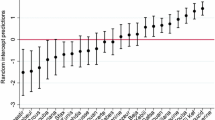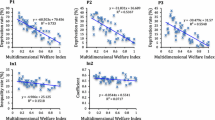Abstract
This study aims to investigate factors contributing to poverty, one of the most significant social problems in Western societies. To this end, 13 countries that have made a variety of efforts to reduce poverty, and therefore experienced similar development processes related to welfare, were selected. To overcome the methodological limitations of previous studies, the study utilized a Hierarchical Generalized Linear Model to simultaneously analyze individual-level and state-level factors that might affect the poverty status of a household, employing household data from the fifth wave of Luxembourg Income Study and Comparative Welfare State data. By comparing the magnitude of individual- and state-level effects in the analysis process, the model can empirically illuminate which of the two levels is more responsible for households’ destitution. Furthermore, by analyzing the level of and characteristics of poverty in each country, this study examines whether there are discrepancies in the level of poverty across types of welfare states and what factors contribute to these discrepancies.


Similar content being viewed by others
Notes
Because the intercept indicates the average log-odds of living in poverty, it corresponds to an odds of 0.104 (e−2.2667). Also, it is equivalent to a probability of 1/(1 + e2.2667) = 0.094.
References
Alesina, A., & Rodrik, D. (1994). Distributive politics and economic growth. The Quarterly Journal of Economics, 109, 465–490.
Anderson, L. (1964). Trickling down, the relationship between economic growth and the extent of poverty of American families. Quarterly Journal of Economics, 78, 511–524.
Atkinson, A. B., Rainwater, L., & Smeeding, T. (1995). Income distribution in OECD countries: Evidence from the luxembourg income study. Paris: OECD.
Becker, G. (1975). Human capital: A theoretical and empirical analysis, with special reference to education. New York: Columbia University Press.
Becker, G. (1993). Human capital. Chicago: The University of Chicago Press.
Bound, J., Duncan, G. J., Laren, D. S., & Oleinick, L. (1991). Poverty dynamics in widowhood. Journal of Gerontology:Social Sciences, 46, S115–S124.
Bourguignon, F., & Morrison, C. (2001). The distribution of income among world citizens. American Economic Review, 5, 1820–1992.
Brady, D., Beckfield, J., & Stephens, J. (2004). Comparative welfare state data set. Retrieved April, 2004, from http://www.lisproject.org/publications/welfaredata/welfareaccess.htm.
Bryk, A., & Raudenbush, S. (2002). Hierarchical linear models: Applications and data analysis methods. (Newbury Park: Sage Publications, Inc).
Buhmann, B., Rainwater, L., Schmaus, G., & Smeeding, T. (1988). Equivalence scales, well-being, inequality, and poverty: Sensitivity estimates across ten countries using the Luxembourg Income Study (LIS) database. Review of Income and Wealth, 34, 115–142.
Burkhauser, R., & Smeeding, T. (1994). Social security reform: A budget neutral approach to reducing older women’s disproportionate risk of poverty. Policy Beief, 2, 1–19.
Burtless, G. (1990). The economist’s lament: Public assistance in America. Journal of Economic Perspectives, 4, 57–78.
Chen, S., & Ravallion, M. (2001). How did the World’s poorest fare in the 1990 s?. Washington DC: World Bank.
Chung, J., Hwang, D., Lee, B., & Choi, K. (2001). Sodeukbulpyeongdeung mit bingoneui s siltaewa jeongchekkwaje. Korean Academy of Social Welfare, 58, 119–141.
Doeringer, P., & Piore, M. J. (1971). Internal labor market and manpower analysis. Armonk: M. E. Sharpe.
Esping-Anderson, G. (1990). The three worlds of welfare capitalism. New Jersey: Princeton University Press.
Esping-Anderson, G. (2000). A welfare state for the 21st century. Report to the Portuguese Presidency of the European Union.
Estes, R. (2002). Poverties and wealth: Competing definitions and alternative approaches to measurement. In W. Glatzer (Ed.), Rich and poor: Disparities, perceptions, concomitants (pp. 9–32). Dordrecht: Kluwer Academic Publishers.
Forder, A. (2000). Theories of welfare. London: RKP.
Förster, M. F. (1993). Comparing poverty in 13 OECD countries: Traditional and synthetic approaches. LIS working paper 100. Differdange, Luxembourg, CEPS/INSTEAD.
Förster, M. F. (1994). The effects of net transfers on low incomes among non-elderly families. OECD Economic Studies, 22, 181–221.
George, V., & Wilding, P. (1985). Ideology and social welfare. London: Routledge.
Hox, J. (2002). Multilevel analysis: Techniques and applications. Mahwah: Lawrence Erlbaum Associates.
June, A., & Mark, J. S. (1988). Dependency and poverty: Old problems in a new world. Lexington, Mass: Lexington Books.
Kim, K., & Choi, Y. (2006). Keunrokyecheungeui kyeoljeongyoinae kwanhan dacheungbunseok (Determinants of the Working Poor: An Analysis Using Hierarchical Generalized Linear Model). Korean Academy of Social Welfare, 58, 119–141.
Kristov, L., Lindert, P., & Mccelland, R. (1992). Pressure groups and redistribution. Journal of Public Economics, 48, 135–143.
Lindsay, L. B. (1999). Skilled temporary speciality workers in the United States. People and Place, 7, 24–32.
LIS variable definition list. Retrieved September 5, 2006, from http://www.lisproject.org/techdoc.htm.
Mandel, H., & Semyonov, M. (2003). Welfare family policies and gender earnings inequality: A cross-national comparative analysis. LIS working paper, 364. Retrieved December, 2003, from http://www.lisproject.org/publications/liswps/364.pdf .
Mishra, R. (1984). The welfare state in crisis: Social thought and social change. (Sussex: Wheatsheaf Books Ltd).
Mitchell, D. (1991). Income transfer in ten welfare states. Brookfield: Gower Publishing Company.
Oxley, J., Fildes, B., Ihsen, E., Charltion, J., & Day, R. (1997). Differences in traffic judgements between young and old adult pedestrians. Accident Analysis and Prevention, 29, 839–847.
Pettit, B., & Hook, J. (2002) The structure of women’s employment in comparative perspective. LIS working paper, 330. Retrieved September, 2002, from http://www.lisproject.org/publications/LISwps/330.pdf.
Pressman, S. (2003). Feminist explanation for feminization of poverty. Journal of Economic Issues, 37, 353–361.
Rank, M., Thomas, A., & Hirschl, A. (1999). Estimating the proportion of Americans ever experiencing poverty during their elderly years. Journal of Gerontology American Sociological Review, 54, 184–193.
Ritakallio, V. (2001). Trends of poverty and income inequality in cross-national comparison. LIS working paper 272. Differdange, Luxembourg, CEPS/INSTEAD.
Smeeding, T. (1989). Poverty, affluence and the income costs of children: Cross-national evidence from the LIS. Journal of Post Keynesian Economics, 2, 222–239.
Smeeding, T. (1997). Poverty in developed countries: The evidence from LIS. In Poverty and human development (pp. 195–240). New York: United Nations.
Smeeding, T. (2002). Globalization, inequality, and the rich countries of the G-20: Evidence from the luxembourg income study. Center for policy research working paper 48. Syracuse: NY Syracuse University.
Smeeding, T., Rainwater, L., & Burtless, G. (2000) United States poverty in a cross-national context. LIS Working Paper, 244. Retrieved September, 2000, from http://www.lisproject.org/publications/liswps/244.pdf.
Stier, H., & Mandel, H. (2003). Inequality in the family: The institutional aspects of wives’ earning dependency. Paper presented at the ISA research committee on stratification (RC28), Tokyo, Japa.
Stiglitz, J. (2003). Globalization and the economic role of the state in the new millennium. Industrial and Corporate Change, 12, 3–26.
Studenmund, A. H. (2001). Using Econometrics: A Practical Guide (4th ed.). Boston, MA: Addison Wesley.
Tai, T., & Treas, J. (2009). Dose household composition explain welfare regime poverty risks for older adults and other household members? Journal of Gerontology: Social Science, 64B(6), 777–787.
Teachman, J., & Crowder, K. (2002). Multilevel models in family research: Some conceptual and methodological issues. Journal of Marriage and Family, 64, 280–294.
Therborn, G. (1986). Welfare states and capitalist market. Acta Sociologica, 30, 237–254.
Titmuss, R. (1974). Social policy. Allen & Unwin: London.
Wilensky, H., & Lebeaux, C. (1965). Industrial society and social welfare. New York: Russell Sage Foundation.
Yang, J. (2004). Kodeunghaksaengeui jaehakjung arbait chamyeoyoin bunseok (Part-Time Work Experience During High School). Academy of Educational Sociology, 14, 17–37.
Author information
Authors and Affiliations
Corresponding author
Rights and permissions
About this article
Cite this article
Kim, Ks., Lee, Y. & Lee, Yj. A Multilevel Analysis of Factors Related to Poverty in Welfare States. Soc Indic Res 99, 391–404 (2010). https://doi.org/10.1007/s11205-010-9592-9
Accepted:
Published:
Issue Date:
DOI: https://doi.org/10.1007/s11205-010-9592-9




